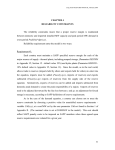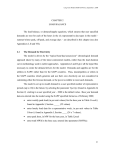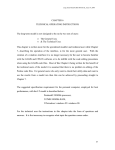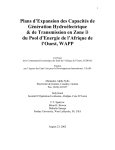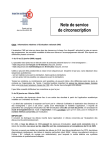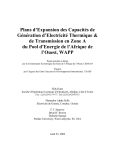Download CHAPTER 4 RELIABILITY CONSTRAINTS The reliability constraints
Transcript
Long Term Model USER MANUAL, June 19, 2000 CHAPTER 4 RELIABILITY CONSTRAINTS The reliability constraints insure that a proper reserve margin is maintained between installed MW capacity and peak period MW demand in every period PeakD(z)*dgr(z,ty). Reliability requirements enter the model in two ways: Requirement #1: Each country must maintain a SAPP specified reserve margin for each of the major sources of supply - thermal plants, including pumped storage, (Parameter RESTHM in Appendix VI, Section 12 - default value 19%) and hydro plants (Parameter RESHYD 10% default value in Appendix V, Section 12). Since the model, as in the real world, allows trade in reserves (imports held by others and exports held for others) to enter into the equation, they must be added (Fmax(ty,zp,z), imports of reserves) and subtracted (Fmax(ty,z,zp) exports of reserves) from the left hand side of the reserve equation. Exports of reserves are simply subtracted, but imports of reserves need to be adjusted downward by the line loss between z and zp; no adjustment for forced outage is necessary, according to SAPP definitions of reserve requirements. As in the case of the demand equation, a country can choose not to “meet” the reserve constraint by choosing a positive value for unsatisfied reserve requirements – variable UM(z,ty), and a cost/MW set by the user parameter UMcost found in Section 1 of Appendix II. (The nominal values set at $10,000/KW in the model.) This cost should reflect the actual capacity cost of a backstop technology used in emergencies to generate electricity, or, equivalently the actual cost of a demand side management program put in place to shave peaks by load shedding during peak periods. 81 Long Term Model USER MANUAL, June 19, 2000 Available Installed Thermal Capacity 1+RESTHM (z ) + Available Installed Hydro Capacity 1+RESHYD(z ) + Reserves held by others to back up firm imports to"z" ( 1 - lineloss ) + UM ( z , ty ) − Re serves held by "z" to back up firm exports to others ≥ [ PeakD(z )*dgr (z ,ty ) − LM (z, th) ][ DLC (z ) ] Note that the choice of RESTHM and RESHYD are behavioral choices; values can be entered to reflect each SAPP member’s attitudes. The choice of FORICN and FORICO, however, are set by the reliability of the lines connecting zp and z. The full equation is as follows; ty PGOinit(z,i)(1 − DecayPGO ) n (ty ) + PGOexpstep(z,i)ÿ PGOexp (τ ,z ,i )(1 − DecayPGO ) n (ty −τ ) τ =1 + ty NTexpstep (z,ni)ÿ PGNTexp (τ ,z ,i )(1 − DecayNT ) n (ty −τ ) τ =1 ty + NSCexpstep (z,ni)ÿ PGNSCexp (τ ,z ,ni )(1 − DecayNSC ) n (ty −τ ) τ =1 + ty existing thermal capacity PGNCCinit (z,ni)ÿ YCC (τ ,z ,ni )(1 − DecayNCC ) n (ty −τ ) τ =1 ty + NCCexpstep (z,ni)ÿ PGNCCexp (τ ,z ,ni )(1 − DecayNCC ) n (ty −τ ) τ =1 + ty PGNLCinit (z,ni)ÿ YLC (τ ,z ,ni )(1 − DecayNLC ) n (ty −τ ) τ =1 ty + NLCexpstep (z,ni)ÿ PGNLCexp (τ ,z ,ni )(1 − DecayNLC ) n (ty −τ ) ty =1 1 + RESTHM (z ) 82 Long Term Model USER MANUAL, June 19, 2000 + + ty HOinit (z,ih)(1 − DecayHO ) n (ty ) + HOV exp step (z,ih)ÿ HOV exp (τ ,z ,ih)(1 − DecayHO ) n (ty −τ ) τ =1 existing hydro capacity + ty ty HNinit (z,nh) ÿ Yh(τ ,z ,nh)(1 − DecayHN ) n (ty −τ ) + HN exp step (z,nh) ÿ HNV exp (τ ,z ,nh)(1 − DecayHN ) n (ty −τ ) τ =1 + τ =1 PGPSOinit (z )(1-DecayPHO) n (ty ) + ÿ phn ty ÿ [ PHNinit (z,phn)Yph(τ ,z ,phn)] (1 − DecayPHN ) τ =1 1+RESHYD (z ) reserves held in ty by country zp for country z , adjusted for loss and transmission forced outage rates + ÿ ( Fmax(ty,zp,z ) ) (1 − PFOloss(zp,z )) zp + unsatisfied reserve requirements peak demand in year ty reserves in ty held by country z for use by country zp UM ( z , ty ) ≥ + [ PeakD ( z ) dgr ( z,ty ) - LM ( z,th )] DLC ( z ) + ÿ Fmax ( ty, z, zp ) zp This reserve margin constraint, as stated in GAMS notation, is equation ResvREG2 and is shown in Appendix VII, Section 14. 4.1 The Autonomy Constraint In addition to system reliability considerations, non-technical, political, and economic factors may require that domestic capacity be maintained at some prescribed fraction of domestic peak demand, regardless of the economic advantages of importing cheap power or reserve capacity. This will be the function of the country autonomy constraint, which reflects the level of autonomy each country wishes to maintain, by specifying a country autonomy factor, AF (z , ty ) ≥ 0 (found in Section 1 of Appendix VI), which reflects each country’s desire to be completely self-sufficient ( AF ≥ 1), willing to depend completely on firm imports during peak, if it is economic to do so ( AF = 0), or something in between; 0 < AF(z,ty) < 1 ; 83 n (ty −τ ) Long Term Model USER MANUAL, June 19, 2000 Available Installed Thermal plus hydro capacity in period ty ≥ ≥ AF (z , ty ) D(peak ,y,z ) - DSM (peak ,y,z ) DLC (z ) ∀ ty,z ,peak These equations are found in Appendix VII, Section 16 for; • all but RSA and MOZ; Equation ResvREG4 • RSA; ResvREG4 a, b, c • MOZ; ResvREG4 d, e, f In addition to each country requiring that domestic production capacity (not involving any reliance upon reserves held by others) always be large enough to satisfy a given fraction of domestic peak demand, a country might also require that a certain fraction of demand in all periods be met by domestic production. This is a far more costly (to SAPP) constraint, because it prevents any trade (beyond that allowed by the constraint) taking place in a given year. This constraint, when added would enter the demand/supply constraint by requiring that x% of domestic production over a year be met by domestic generation- e.g. ÿ PG(ty, ts, td , th, z, i) + ÿ PGN (ty, ts, td , th, z, ni) i ni +ÿ H (ty, ts, td , th, z , ih) + ÿ Hnew(ty, ts, td , th, z , nh) ≥ Enaf ( z, ty ) Demand ih nh in all hours, days, seasons, and years, where Enaf(z,ty) is the fraction of demand in country z during year ty which must be met by domestic production (Table Enaf(z,ty) Section 1, Appendix I). These equations are found in Appendix VII, Section 26 and is called “Equation Energy AF”, a, b, c (RSA), d, e, f (MOZ). It is only for illustrative purposes, the base runs do not include this constraint. 84 Long Term Model USER MANUAL, June 19, 2000 4.2 The Treatment of Capacity and Energy Trading and Firm and Non-firm Power in the Model In an ideal world with no limits on computer memory and running time, models such as ours would distinguish in the optimization between two types of power – Firm power, as defined in section 2.17 Article 1 of SAPP’s ABOM, and economy energy, as defined in section 2.11 of the same document. To conserve on memory and running time Purdue’s model does not distinguish between the two power flows during the optimization, but does allow users to distinguish between them after the optimization. A) Splitting up power flows into firm and non-firm components The characteristic of firm power flow is that the exporting country must have on hand, either in the form of its own generating capacity, or capacity available from other countries, sufficient capacity to always provide such power to the importing country. In our model, this capacity commitment [or as section 2.27 puts it, “the lease of a specific generating unit (or units) or a portion of such unit(s)”] is the variable Fmax(ty,z,zp), representing country z’s “leasing” of capacity in ty to country zp. Once Fmax(ty,z,zp) is known, along with the flow variables PF(ty,ts,td,th,z,zp) and PFnew(ty,ts,td,th,z,zp), the following rules can be used to split up the flows between z and zp into firm and economy trade; Case A power flows exceed Fmax If PF(ty,ts,td,th, z,zp)+ PFnew(ty,ts,td,th,z,zp)> Fmax(ty,z,zp); Firm = Fmax(ty,z,zp) economy = PF(ty,ts,tdt,th,z,zp)+ PFnew ( ty,ts,td,th,z,zp ) - Fmax(ty,z,zp) Case B Power flows less than or equal to Fmax If PF(ty,ts,td,th,z, zp)+ PFnew(ty,ts,td,th,z,zp)/ Fmax(ty,z,zp) then; Firm = PF(ty,ts,td,th,z,zp)+ PFnew(ty,ts,td,th,z,zp) Economy = 0 85 Long Term Model USER MANUAL, June 19, 2000 Thus, all power flows are firm, unless power flows exceed the capacity commitment represented by Fmax(ty,z,zp); only the excess (if any) of power flows over Fmax(ty,z,zp) should be considered economy sales, since such sales are not backed up by any committed capacity in the exporting country (e.g. “non-capacity, non-firm transactions” – SAPP ABOM, service schedule “e”). B) Treatment in the Transmission Capacity Constraint The flow variables for old and new lines - PF(ty,ts,td,th,z,zp) and PFnew(ty,ts,td,th,z,zp) - power flows from country z to country zp in a given time slice – give the total flow between two countries consisting of the sum of all firm and non-firm power trades. Thus, the transmission capacity flow constraints for old lines involve only PF(ty,ts,td,th,z,zp) and the current capacity of the old lines connecting z to zp – e.g., for old lines (ignoring decay and forced outages); ty PF ( ty,ts,td,th,z, zp ) ≤ PFinit ( z,zp ) + ÿ PFOVexp ( tye, z,zp ) tye =1 a similar equation holds for new lines. In addition, a constraint requiring that there be sufficient transmission capacity at all times to handle the import/export of reserves must be added; e.g. the sum of current new and old transmission capacity, derated by decay and forced outage, ≥ Fmax(ty,z,zp) C) Treatment in the Load Balance Constraints The hourly load balances which require that supplies must equal demands, involve only domestic generation, power imports, power exports, and demand. Ignoring both unserved and dumped energy the load balance equation for the time slice (ty,ts,td,th) is simply; 86 Long Term Model USER MANUAL, June 19, 2000 Sum of all Domestic Generation + ÿ PF(ty,ts,td,th, zp,z) ( 1- lineloss ) = in (ty,ts,td,th) zp Demand in (ty,ts,td,th,z, zp)+ÿ PF(ty,ts,td,th,z,zp) zp No distinction is made between firm and non-firm power in meeting demand, nor should there be; both can interchangeably satisfy the load balance equation. D) Treatment in the Reliability Constraints According to section 2.33 and Appendix I of the SAPP ABOM, the reserve capacity obligation of each country can be expressed as; Thermal Capacity Hydro Capacity + ≥ Peak Demand - Firm Power 1.19 1.10 Purchases + Firm Power Sales Since firm power purchases/sales are not variables in the model, we use leased capacity purchases/sales (Fmax(ty,z,zp)) in the equation, the purchases suitably adjusted for line loss and outage rates; Thermal Capacity in ty Hydro Capacity in ty + + ÿ Fmax ( ty,zp,z )(1 − lineloss ) 1.19 1.10 zp ≥ Peak Demand ( ty, z ) + ÿ Fmax ( ty,z, zp ) zp To summarize: • Power flows between countries can after the fact be broken down into firm and non-firm power; • Both the transmission and load balance constraints consider only the total flows of firm and non-firm power. 87







